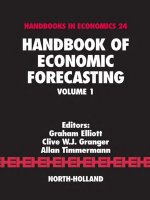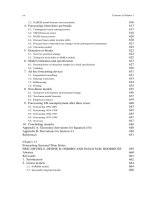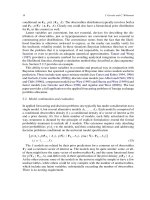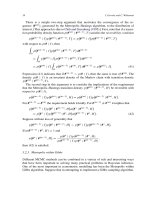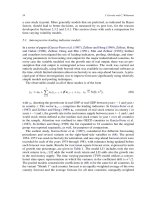Handbook of Economic Forecasting part 87 ppsx
Bạn đang xem bản rút gọn của tài liệu. Xem và tải ngay bản đầy đủ của tài liệu tại đây (114.78 KB, 10 trang )
834 T.G. Andersen et al.
assumptions based primarily upon arbitrage-free financial markets. As such it allows us
to harness the information inherent in high-frequency returns for assessment of lower
frequency return volatility. It is thus the natural approach to measuring actual (ex-
post) realized return variation over a given horizon. This perspective has now gained
widespread acceptance in the literature, where alternative volatility forecast models are
routinely assessed in terms of their ability to explain the distribution of subsequent re-
alized volatility, as defined above.
5.2. Realized volatility modeling
The realized volatility is by construction an observed proxy for the underlying quadratic
variation and the associated (measurement) errors are uncorrelated. This suggests a
straightforward approach where the temporal features of the series are modeled through
standard time series techniques, letting the data guide the choice of the appropriate
distributional assumptions and the dynamic representation. This is akin to the stan-
dard procedure for modeling macroeconomic data where the underlying quantities are
measured (most likely with a substantial degree of error) and then treated as directly
observed variables.
The strategy of estimating time series models directly for realized volatility is ad-
vocated in a sequence of papers by Andersen et al. (2001a, 2001b, 2003). A strik-
ing finding is that the realized volatility series share fundamental statistical proper-
ties across different asset classes, time periods, and countries. The evidence points
strongly toward a long-memory type of dependency in volatility. Moreover, the loga-
rithmic realized volatility series is typically much closer to being homoskedastic and
approximately unconditionally Gaussian. These features are readily captured through
an ARFIMA(p, d, 0) representation of the logarithmic realized volatility,
(5.14)Φ(L)(1 −L)
d
log RV(t, ) − μ
0
= u
t
,t= 1, 2, ,T,
where (1 − L)
d
denotes the fractional differencing operator, Φ(L) is a polynomial lag
operator accounting for standard autoregressive structure, μ
0
represents the uncondi-
tional mean of the logarithmic realized volatility, and u
t
is a white noise error term that
is (approximately) Gaussian. The coefficient d usually takes a value around 0.40, con-
sistent with a stationary but highly persistent volatility process for which shocks only
decay at a slow hyperbolic rate rather than the geometric rate associated with standard
ARMA models or GARCH models for the conditional variance. Finally, the volatility
of volatility is strongly increasing in the level of volatility as log-realized volatility is
approximately homoskedastic. This is, of course, reminiscent of the log-SV and the
EGARCH models.
A number of practical modeling issues have been sidestepped above. One is the
choice of the sampling frequency at which the realized volatility measures are con-
structed. The early literature focused primarily on determining the highest intraday
frequency at which the underlying returns satisfy the maintained semi-martingale as-
sumption of being approximately uncorrelated. An early diagnostic along these lines
Ch. 15: Volatility and Correlation Forecasting 835
termed the “volatility signature plot” was developed by Andersen et al. (1999, 2000),as
discussed further in Section 7 below. A simple alternative is to apply standard ARMA
filtering to the high-frequency returns in order to strip them of any “artificial” serial cor-
relation induced by the market microstructure noise, and then proceed with the filtered
uncorrelated returns in lieu of the raw high-frequency returns. While none of these pro-
cedures are optimal in a formal statistical sense, they both appear to work reasonable
well in many practical situations. Meanwhile, a number of alternative more efficient
sampling schemes under various assumptions about the market microstructure compli-
cations have recently been proposed in a series of interesting papers, and this is still
very much ongoing research.
A second issue concerns the potential separation of jumps and diffusive volatility
components in the realized volatility process. The theoretical basis for these proce-
dures and some initial empirical work is presented in Barndorff-Nielsen and Shephard
(2004a). The issue has been pursued empirically by Andersen, Bollerslev and Diebold
(2003), who find compelling evidence that the diffusive volatility is much more per-
sistent than the jump component. In fact, the jumps appear close to i.i.d., although the
jumps in equity indices display some clustering, especially in the size of the jumps. This
points to potentially important improvements in modeling and forecasting from this type
of separation of the realized volatility into sudden discrete shifts in prices versus more
permanent fluctuations in the intensity of the regular price movements. Empirically,
this is in line with the evidence favoring non-Gaussian fat-tailed return innovations in
ARCH models.
A third issue is the approach used to best accommodate the indications of “long
memory”. An alternative to fractional integration is to introduce several autoregressive
volatility components into the model. As discussed in the context of the GARCH class
of models in Section 3.4, if the different components display strong, but varying, degrees
of persistence they may combine to produce a volatility dependency structure that is
indistinguishable from long memory over even relatively long horizons.
5.3. Realized volatility forecasting
Forecasting is straightforward once the realized volatility has been cast within the tra-
ditional time series framework and the model parameters have been estimated. Since
the driving variable is the realized volatility we no longer face a latent variable issue.
This implies that standard methods for forecasting a time series within the ARFIMA
framework is available; see, e.g., Beran (1994) for an introduction to models incorporat-
ing long-memory features. One-step-ahead minimum mean-squared error forecasts are
readily produced, and within the linear Gaussian setting it is then legitimate to further
condition on the forecast in order to iterate forward and produce multiple-step-ahead
forecasts. There are a couple of caveats, however. First, as with most other volatility
forecasting procedures, the forecasts are, of course, conditional on the point estimate
for the model parameters. Second, if the model is formulated in terms of the logarithmic
volatility then it is also log volatility that is being predicted through the usual forecast
836 T.G. Andersen et al.
procedures. There is a practical problem of converting the forecast for log volatility into
a “pure” volatility forecast as the expected value of the transformed variable depends
not only on the expected log volatility, but on the entire multiple-step-ahead conditional
distribution of log volatility. For short horizons this is not an issue as the requisite cor-
rection term usually is negligible, but for longer horizons adjustments may be necessary.
This is similar to the issue that arise in the construction of forecast form the EGARCH
model. As discussed in Section 3.6, the required correction term may be constructed by
simulation based methods, but the preferred approach will depend on the application at
hand and the distributional characteristics of the model. For additional inspiration on
how to address such issues consult, e.g., Chapter 6 on ARMA forecasting methods by
Lütkepohl (2006) in this handbook.
A few additional comments are in order. First, the evidence in Andersen, Bollerslev
and Diebold (2005) indicates that the above approach has very good potential. The as-
sociated forecasts for foreign exchange rate volatility outperform a string of alternative
candidate models from the literature. This is not a tautology as it should be preferable
to generate the forecasts from the true underlying model rather than an ad hoc time se-
ries model estimated from period-by-period observations of realized volatility. In other
words, if a GARCH diffusion is the true model then optimal forecasts would incorporate
the restrictions implied by this model. However, the high-frequency volatility process is
truly complex, possessing several periodic components, erratic short run dynamics and
longer run persistence features that combined appear beyond reach of simple parametric
models. The empirical evidence suggests that daily realized volatility serves as a simple,
yet effective, aggregator of the volatility information inherent in the intraday data.
Second, there is an issue of how to compute realized volatility for a calendar period
when the trading day is limited by an official closing. This problem is minor for the
over-the-counter foreign exchange market where 24-hour trading is observed, but this
is often not the case for equity or bond markets. For example, for a one-month-ahead
equity volatility forecast there may only be twenty-two trading days with about six-and-
a-half hours of trading per day. But the underlying price process is not stalled while the
markets are closed. Oftentimes there will be substantial changes in prices between one
market close and the subsequent opening, reflecting return volatility overnight and over
the weekend. One solution is to simply rely on the intraday returns for a realized volatil-
ity measure over the trading day and then scale this quantity up by a factor that reflects
the average ratio of volatility over the calendar day versus the trading day. This may
work quite satisfactorily in practice, but it obviously ignores the close-to-open return
for a given day entirely in constructing the realized volatility for that calendar day. Al-
ternatively, the volatility of the close-to-open return may be modeled by a conventional
GARCH type model.
Third, we have not discussed the preferred sampling frequency of intraday returns in
situations where the underlying asset is relatively illiquid. If updated price observations
are only available intermittently throughout the trading day, many high-frequency re-
turns may have to be computed from prices or quotes earlier in the day. This brings up a
couple of issues. One, the effective sampling frequency is lower than the one that we are
Ch. 15: Volatility and Correlation Forecasting 837
trying to use for the realized volatility computation. Two, illiquid price series also tend
to have larger bid–ask spreads and be more sensitive to random fluctuations in order
flow, implying that the associated return series will contain a relatively large amount of
noise. A simple response that will help alleviate both issues is to lower the sampling
frequency. However, with the use of less intraday returns comes a larger measurement
error in realized volatility, as evidenced by Equation (5.12). Nonetheless, for an illiquid
asset it may only be possible to construct meaningful weekly rather than daily realized
volatility measures from say half-hourly or hourly return observations rather than five-
minute returns. Consequently, the intertemporal fluctuations are smoothed out so that
the observed measure carries less information about the true state of the volatility at the
end of the period. This, of course, can be critically important for accurate forecasting.
In sum, the use of the realized volatility measures for forecasting is still in its infancy
and many issues must be explored in future work. However, it is clear that the use of
intraday information has large potential to improve upon the performance of standard
volatility forecast procedures based only on daily or lower frequency data. The real-
ized volatility approach circumvents the need to model the intraday data directly and
thus provides a great deal of simplification. Importantly, it seems to achieve this ob-
jective without sacrificing a lot of efficiency. For example, Andersen, Bollerslev and
Meddahi (2004) find the time series approach built directly from the realized volatil-
ity measures to be very good approximations to the theoretically optimal procedures in
a broad class of SV diffusion models that can be analyzed analytically through newly
developed tools associated with the so-called Eigenfunction SV models of Meddahi
(2001). Nonetheless, if the objective exclusively is volatility forecasting, some very re-
cent work suggests that alternative intraday measures may carry even more empirically
relevant information regarding future volatility, including the power variation measures
constructed from cumulative absolute returns; see, e.g., Ghysels, Santa-Clara and Valka-
nov (2004). This likely reflects superior robustness features of absolute versus squared
intraday returns, but verification of such conjectures awaits future research. The conflu-
ence of compelling empirical performance, novel econometric theory, the availability of
ever more high-frequency data and computational power, and the importance of forecast
performance for decision making render this approach fertile ground for new research.
5.4. Further reading
The realized volatility approach has a precedent in the use of cumulative daily squared
returns as monthly volatility measures; see, e.g., French, Schwert and Stambaugh(1987)
and Schwert (1989). Hsieh (1989) was among the first to informally apply this same
procedure with high-frequency intraday returns, while Zhou (1996) provides one of the
earliest formal assessments of the relationship between cumulative squared intraday
returns and the underlying return variance, albeit in a highly stylized setting. The pio-
neering work by Olsen & Associates on the use of high-frequency data, as summarized
in Dacorogna et al. (2001), also importantly paved the way for many of the more recent
empirical developments in the realized volatility area.
838 T.G. Andersen et al.
The use of component structures and related autoregressive specifications for ap-
proximating long-memory dependencies within the realized volatility setting has been
explored by Andersen, Bollerslev and Diebold (2003), Barndorff-Nielsen and Shep-
hard (2001), Bollerslev and Wright (2001), and Corsi (2003), among others. The fi-
nite sample performance of alternative nonparametric tests for jumps based on the
bipower variation measure introduced by Barndorff-Nielsen and Shephard (2004a)
have been extensively analyzed by Huang and Tauchen (2004). Andersen, Bollerslev
and Diebold (2003) demonstrate the importance of disentangling the components of
quadratic variation corresponding to jumps versus diffusion volatility for volatility fore-
casting. The complexities involved in a direct high-frequency characterization of the
volatility process is also illustrated by Andersen and Bollerslev (1998c).
Ways of incorporating noisy overnight returns into the daily realized volatility mea-
sure are discussed in Fleming, Kirby and Ostdiek (2003) and Hansen and Lunde
(2004a). The related issue of measuring the integrated variance in the presence of mar-
ket microstructure noise and how to best use all of the available high frequency data
has been addressed in a rapidly growing recent literature. Corsi et al. (2001) argue for
the use of exponential moving average filtering, similar to a standard MA(1) filter for
the high-frequency returns, while other more recent procedures, including sub-sampling
and ways of choosing the “optimal” sampling frequency, have been suggested and ana-
lyzed empirically by, e.g., Aït-Sahalia, Mykland and Zhang (2005), Bandi and Russell
(2004), Barucci and Reno (2002), Bollen and Inder (2002), Curci and Corsi (2004), and
Hansen and Lunde (2004b), among others. Some of these issues are discussed further
in Section 7 below, where we also consider the robust alternative range based volatil-
ity estimator recently explored by Alizadeh, Brandt and Diebold (2002) for dynamic
volatility modeling and forecasting.
Implied volatility provides yet another forward looking volatility measure. Implied
volatilities are based on the market’s forecasts of future volatilities extracted from the
prices of options written on the asset of interest. As discussed in Section 2.2.4 above,
using a specific option pricing formula, one may infer the expected integrated volatil-
ity of the underlying asset over the remaining time-to-maturity of the option. The main
complication associated with the use of these procedures lies in the fact that the op-
tion prices also generally reflect a volatility risk premium in the realistic scenario where
the volatility risk cannot be perfectly hedged; see, e.g., the discussion in Bollerslev and
Zhou (2005). Nonetheless, many studies find options implied volatilities to provide use-
ful information regarding the future volatility of the underlying asset. At the same time,
the results pertaining to the forecast performance of implied volatilities are somewhat
mixed, and there is still only limited evidence regarding the relative predictive power of
implied volatilities versus the realized volatility procedures discussed above. Another
issue is that many assets of interest do not have sufficiently active options markets that
reliable implied volatilities can be computed on, say, a daily basis.
Ch. 15: Volatility and Correlation Forecasting 839
6. Multivariate volatility and correlation
The discussion in the preceding three sections has been focused almost exclusively on
univariate forecasts. Yet, as discussed in Section 2, in many practical situations covari-
ance and/or correlation forecasting plays an equal, if not even more important, role
in the uses of volatility forecasts. Fortunately, many of the same ideas and procedures
discussed in the context of univariate forecasts are easily adapted to the multivariate set-
ting. However, two important complications arise in this setting, namely the imposition
of sufficient conditions to ensure that the forecasts for the covariance matrix remain
positive definite for all forecasting horizons, and, second, maintaining an empirically
realistic yet parsimoniously parameterized model. We will organize our discussion of
the various multivariate approaches with these key concerns in mind.
Before turning to this discussion, it is worth noting that in many situations, multivari-
ate volatility modeling and forecasting may be conveniently sidestepped through the
use of much-simpler-to-implement univariate procedures for appropriately transformed
series. In particular, in the context of financial market volatility forecasting, consider
the leading case involving the variance of a portfolio made up of N individual assets. In
the notation of Section 2.2.1 above,
(6.1)r
w,t+1
=
N
i=1
w
i,t
r
i,t+1
≡ w
t
R
t+1
.
The conditional one-step-ahead variance of the portfolio equals
(6.2)σ
2
w,t+1|t
=
N
i=1
N
j=1
w
i,t
w
j,t
{Ω
t+1|t
}
i,j
= w
t
Ω
t+1|t
w
t
,
where Ω
t+1|t
denotes the N × N covariance matrix for the returns. A forecast for the
portfolio return variance based upon this representation therefore requires the construc-
tion of multivariate forecasts for the
1
2
N(N + 1) unique elements in the covariance
matrix for the assets in the portfolio. Alternatively, define the univariate time series
of artificial historical portfolio returns constructed on the basis of the weights for the
current portfolio in place,
(6.3)r
t
w,τ
≡ w
t
R
τ
,τ= 1, 2, ,t.
A univariate forecast for the variance of the returns on this artificially constructed
portfolio indirectly ensures that the covariances among the individual assets receive
exactly the same weight as in Equation (6.2). Note, that unless the portfolio weights
for the actual portfolio in place are constantly rebalanced, the returns on this artifi-
cially constructed portfolio will generally differ from the actual portfolio returns, that
is r
t
w,τ
≡ w
t
R
τ
≡ w
τ
R
τ
≡ r
w,τ
for τ = t. As such, the construction of the vari-
ance forecasts for r
t
w,τ
requires the estimation of a new (univariate) model each period
to properly reflect the relevant portfolio composition in place at time t. Nonetheless,
840 T.G. Andersen et al.
univariate volatility models are generally much easier to implement than their multi-
variate counterparts, so that this approach will typically be much less computationally
demanding than the formulation of a satisfactory full scale multivariate volatility model
for Ω
t+1|t
, especially for large values of N. Moreover, since the relative changes in
the actual portfolio weights from one period to the next are likely to be small, good
starting values for the parameters in the period-by-period univariate models are readily
available from the estimates obtained in the previous period. Of course, this simplified
approach also requires that historical returns for the different assets in the portfolio are
actually available. If that is not the case, artificial historical prices could be constructed
from a pricing model, or by matching the returns to those of other assets with similar
characteristics; see, e.g., Andersen et al. (2005) for further discussion along these lines.
Meanwhile, as discussed in Sections 2.2.2 and 2.2.3, there are, of course, many sit-
uations in which forecasts for the covariances and/or correlations play a direct and
important role in properly assessing and comparing the risks of different decisions or in-
vestment opportunities. We next turn to a discussion of some of the multivariate models
and forecasting procedures available for doing so.
6.1. Exponential smoothing and RiskMetrics
The exponentially weighted moving average filter, championed by RiskMetrics, is ar-
guable the most commonly applied approach among finance practitioners for estimating
time-varying covariance matrices. Specifically, let Y
t
≡ R
t
denote the N × 1 vector of
asset returns. The estimate for the current covariance matrix is then defined by
(6.4)
ˆ
Ω
t
= γY
t
Y
t
+ (1 − γ)
ˆ
Ω
t−1
≡ γ
∞
i=1
(1 − γ)
i−1
Y
t
Y
t
.
This directly parallels the earlier univariate definition in Equation (3.2), with the ad-
ditional assumption that the mean of all the elements in Y
t
is equal to zero. As in the
univariate case, practical implementation is typically done by truncating the sum at
I = t − 1, scaling the finite sum by 1/[1 − (1 − γ)
t
]. This approach is obviously very
simple to implement in any dimension N, involving only a single tuning parameter, γ ,
or by appealing to the values advocated by RiskMetrics (0.06 and 0.04 in the case of
daily and monthly returns, respectively) no unknown parameters whatsoever. Moreover,
the resulting covariance matrix estimates are guaranteed to be positive definite.
The simple one-parameter filter in (6.4) may, of course, be further refined by allowing
for different decay rates for the different elements in
ˆ
Ω
t
. Specifically, by using a smaller
value of γ for the off-diagonal, or covariance, terms in
ˆ
Ω
t
, the corresponding time-
varying correlations,
(6.5)ˆρ
ij,t
≡
{
ˆ
Ω
t
}
ij
{
ˆ
Ω
t
}
1/2
ii
{
ˆ
Ω
t
}
1/2
jj
,
Ch. 15: Volatility and Correlation Forecasting 841
will exhibit more persistent dynamic dependencies. This slower rate of decay for the
correlations often provide a better characterization of the dependencies across assets.
Meanwhile, the h-period-ahead forecasts obtained by simply equating the future con-
ditional covariance matrix with the current filtered estimate,
(6.6)Var(Y
t+h
| F
t
) ≡ Ω
t+h|t
≈
ˆ
Ω
t
,
are plagued by the same counterfactual implications highlighted in the context of the
corresponding univariate filter in Sections 3.1 and 3.2. In particular, assuming that the
one-period returns are serially uncorrelated so that the forecast for the covariance ma-
trix of the multi-period returns equals the sum of the successive one-period covariance
forecasts,
(6.7)Var(Y
t+k
+ Y
t+k−1
+···+Y
t+1
| F
t
) ≡ Ω
t:t+k|t
≈ k
ˆ
Ω
t
,
the multi-period covariance matrix scales with the forecast horizon, k, rather than incor-
porating empirically more realistic mean-reversion. Moreover, it is difficult to contem-
plate the choice of the tuning parameter(s), γ , for the various elements in
ˆ
Ω
t
without
a formal model. The multivariate GARCH class of models provides an answer to these
problems by formally characterizing the temporal dependencies in the forecasts for the
individual variances and covariances within a coherent statistical framework.
6.2. Multivariate GARCH models
The multivariate GARCH class of models was first introduced and estimated empiri-
cally by Bollerslev, Engle and Wooldridge (1988). Denoting the one-step-ahead con-
ditional mean vector and covariance matrix for Y
t
by M
t|t−1
≡ E(Y
t
| F
t−1
) and
Ω
t|t−1
≡ Va r(Y
t
| F
t−1
), respectively, the multivariate version of the decomposition
in (3.5) maybeexpressedas
(6.8)Y
t
= M
t|t−1
+ Ω
1/2
t|t−1
Z
t
,Z
t
∼ i.i.d.,E(Z
t
) = 0, Va r(Z
t
) = I,
where Z
t
now denotes a vector white noise process with unit variances. The square
root of the Ω
t|t−1
matrix is not unique, but any operator satisfying the condition that
Ω
1/2
t|t−1
· Ω
1/2
t|t−1
≡ Ω
t|t−1
will give rise to the same conditional covariance matrix.
The multivariate counterpart to thesuccessfulunivariate GARCH(1, 1) model in (3.6)
is now naturally defined by
(6.9)vech(Ω
t|t−1
) = C +A vech
e
t−1
e
t−1
+ B vech(Ω
t−1|t−2
),
where e
t
≡ Ω
1/2
t|t−1
Z
t
, vech(·) denotes the operator that stacks the
1
2
N(N + 1) unique
elements in the lower triangular part of a symmetric matrix into a
1
2
N(N + 1) × 1
vector, and the parameter matrices C, A, and B, are of dimensions
1
2
N(N + 1) × 1,
1
2
N(N + 1) ×
1
2
N(N + 1), and
1
2
N(N + 1) ×
1
2
N(N + 1), respectively. As in the
univariate case, the GARCH(1, 1) model in (6.9) is readily extended to higher order
842 T.G. Andersen et al.
models by including additional lagged terms on the right-hand side of the equation.
Note, that for N = 1 the model in (6.9) is identical to formulation in (3.6),butfor
N>1 each of the elements in the covariance matrix is allowed to depend (linearly) on
all of the other lagged elements in the conditional covariance matrix as well as the cross
products of all the lagged innovations.
The formulation in (6.9) could also easily be extended to allow for asymmet-
ric influences of past negative and positive innovations, as in the GJR or TGARCH
model in (3.11), by including the signed cross-products of the residuals on the
right-hand side. The most straightforward generalization would be to simply include
vech(min{e
t−1
, 0}min{e
t−1
, 0}
), but other matrices involving the cross-products of
max{e
t−1
, 0}and/or min{e
t−1
, 0}have proven important in someempirical applications.
Of course, other exogenous explanatory variables could be included in a similar fashion.
Meanwhile, multi-step-ahead forecasts for the conditional variances and covariances
from the linear model in (6.9) are readily generated by recursive substitution in the
equation,
vech(Ω
t+h|t+h−1
) = C +A vech(F
t+h−1|t+h−2
)
(6.10)+ B vech(Ω
t+h−1|t+h−2
),
where by definition,
F
t+h|t+h−1
≡ e
t+h
e
t+h
,h 0,
and
F
t+h|t+h−1
≡ Ω
t+h|t+h−1
,h 1.
These recursions, and their extensions to higher order models, are, of course, easy to
implement on a computer. Also, provided that the norm of all the eigenvalues of A +B
are less than unity, the long-run forecasts for Ω
t+h|t
will converge to the “unconditional
covariance matrix” implied by the model, (I −A−B)
−1
C, at the exponential rate of de-
cay dictated by (A +B)
h
. Again, these results directly mirror the univariate expressions
in Equations (3.8) and (3.9).
Still, nothing guarantees that the “unconditional covariance matrix” implied by (6.9),
(I − A − B)
−1
C, is actually positive definite, nor that the recursion in (6.10) results
in positive definite h-step ahead forecasts for the future covariance matrices. In fact,
without imposing any additional restrictions on the C, A, and B parameter matrices, the
forecasts for the covariance matrices will most likely not be positive definite. Also, the
unrestricted GARCH(1, 1) formulation in (6.9) involves a total of
1
2
N
4
+ N
3
+ N
2
+
1
2
N unique parameters. Thus, for N = 5 the model has 465 parameters, whereas for
N = 100 there is a total of 51,010,050 parameters! Needless to say, estimation of this
many free parameters isn’t practically feasible. Thus, various simplifications designed
to ensure positive definiteness and a more manageable number of parameters have been
developed in the literature.
Ch. 15: Volatility and Correlation Forecasting 843
In the diagonal vech model the A and B matrices are both assumed to be diagonal,
so that a particular element in the conditional covariance matrix only depends on its
own lagged value and the corresponding cross product of the innovations. This model
may alternatively be written in terms of Hadamard products, or element-by-element
multiplication, as
(6.11)Ω
t|t−1
= C + A ◦
e
t−1
e
t−1
+ B ◦ Ω
t−1|t−2
,
where C, A, and B now denote symmetric positive definite matrices of dimension
N × N. This model greatly reduces the number of free parameters to 3(N
2
+N)/2, and,
importantly, covariance matrix forecasts generated from this model according to the re-
cursions in (6.10) are guaranteed to be positive definite. However, the model remains
prohibitively “expensive” in terms of parameters in large dimensions. For instance, for
N = 100 there are still 15,150 free parameters in the unrestricted diagonal vech model.
A further dramatic simplification is obtained by restricting all of the elements in the
A and B matrices in (6.11) to be the same,
(6.12)Ω
t|t−1
= C + α
e
t−1
e
t−1
+ βΩ
t−1|t−2
.
This scalar diagonal multivariate GARCH representation mimics the RiskMetrics ex-
ponential smoother in Equation (6.4), except for the positive definite C matrix inter-
cept, and the one additional smoothing parameter. Importantly however, provided that
α +β<1, the unconditional covariance matrix implied by the model in (6.12) equals
Ω = (1 −α −β)
−1
C, and in parallel to the expression for the univariate GARCH(1, 1)
model in Equation (3.9),theh-period forecasts mean reverts to Ω according to the for-
mula,
Ω
t+h|t
= Ω + (α +β)
h−1
(Ω
t+1|t
− Ω).
This contrasts sharply with the RiskMetrics forecasts, which as previously noted show
no mean reversion, with the counterfactual implication that the multi-period covariance
forecasts for (approximately) serially uncorrelated returns scale with the forecast hori-
zon. Of course, the scalar model in (6.12) could easily be refined to allow for different
(slower) decay rates for the covariances by adding just one or two additional parameters
to describe the off-diagonal elements. Still, the model is arguably too simplistic from an
empirical perspective, and we will discuss other practically feasible multivariate mod-
els and forecasting procedures in the subsequent sections. Before doing so, however,
we briefly discuss some of the basic principles and ideas involved in the estimation of
multivariate GARCH models.
6.3. Multivariate GARCH estimation
Estimation and inference for multivariate GARCH models may formally proceed along
the same lines as for the univariate models discussed in Section 3.5. In particular, as-
sume that the conditional distribution of Y
t
is multivariate normal with mean, M
t|t−1
,

